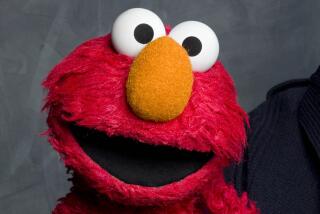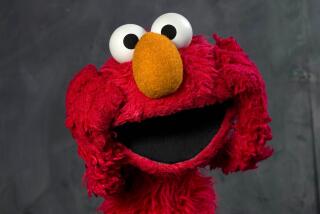‘Sesame Street’ Travels Down a New Road
NEW YORK — Getting to “Sesame Street” is going to be a little bit easier for the show’s youngest viewers, starting today.
The home of Big Bird and Elmo enters its 33rd season with what it is calling its most extensive overhaul, a result of intense competition in the children’s TV arena and an audience that is getting ever younger.
The overall goal was to make the show simpler to follow. Some of the changes are subtle, but others, such as a “Journey to Ernie” segment designed to look like a CD-ROM game, may prove startling to longtime viewers, and possibly a risk to the show.
Still, executives at parent Sesame Workshop say the alterations are needed to keep the program, which has seen its ratings slip in recent years, vital at a time when there are more options for children.
“We have no control over societal changes; we just try to keep up with them,” said Arlene Sherman, co-executive producer.
The franchise started in 1968 as a show designed to prepare 3- to 5-year-olds for school. But its success soon drew more and more players into the children’s TV business, with shows such as “Barney” and “Teletubbies” aimed at even younger children, and Nickelodeon programs such as “Blue’s Clues” promoting interactivity. Parents and day-care providers raised on “Sesame Street,” eager to give children an educational head start, also began putting younger and younger children in front of the TV set.
As a result, the show is now watched more by 2- to 4-year-olds. For a program grounded in extensive educational research, even one year can mean a big difference in both the curriculum the program teaches and how those children learn.
In the summer of 2000, Sesame Workshop started to put change in motion, convening a summit to brainstorm with an array of children’s entertainers, including rivals. Then a year ago, producers gathered with “Sesame Street” writers and “deconstructed what’s sacred and what’s not,” said Sherman. “We know what’s at stake here, and we don’t want to throw the baby out with the bathwater.” There was also a concern that the show not be “dumbed down” so much that children weren’t challenged.
The humor and characters that children identify with were indispensable, Sherman said. But what she calls the show’s “laissez-faire format” had to give way. Also complicating the picture were kids’ familiarity these days with computers and other video forms and the show’s hour length in a world where most shows are 30 minutes.
In its biggest change to appeal to the younger crowd, “Sesame Street” has broken itself into segments that will air at the same time every day, just as a segment called “Elmo’s World” has since 1999. The predictability mimics the nap and snack routines of toddlers.
The “Street Story” will now air in a single 10-minute block from beginning to end, instead of being woven throughout the show. In addition, the “Letter of the Day” will always be introduced (and eventually, eaten) by Cookie Monster, and the day’s number by the Count. Rosita will present a Spanish word each day.
The “Journey to Ernie” segment is a direct response to new video technologies. Big Bird and Ernie appear caught up in a CD-ROM game, playing hide-and-seek; on today’s show, when Big Bird ducks under a bridge, he finds himself in outer space. Children are encouraged to help Big Bird solve the problem of where to find Ernie.
Kids probably won’t notice the academic distinction, but Sherman said “Sesame Street” has also taken a new stance on how to teach numbers. The program has always displayed what numbers look like but now will reinforce that by using animation and live-action films, showing “not just what the symbol is, but that 10 things, no matter how configured, is still 10,” she said.
The changes are being accompanied by a major promotional push, including a live appearance this morning by Big Bird, Elmo and executive producer Michael Loman on NBC’s “Today” show. In a nod to the more competitive world of children’s TV, Sesame Workshop has also stepped up marketing and product tie-ins for the program. Bubble bath and purified water are just some of the latest products to carry a “Sesame Street” brand.
Sesame Workshop has won praise over the years for keeping the show relevant for three decades. Longtime children’s television advocate Peggy Charren hasn’t seen the current changes but said the ones being discussed make sense. “For a long time they were almost the only program like that on the tube, and now all of children’s TV has competition,” she said.
One question is whether the revisions will simplify the show too much for parents. Producers have always tried to encourage parents to watch with their children, but adding a second level of meaning in the writing this year was “much more of a challenge,” Sherman said.
Celebrities such as musical group Destiny’s Child, actor Ray Romano and United Nations Secretary-General Kofi Annan have always been included largely for the parents’ benefit, and about the same number will appear this season.
There will also be an attempt to address issues stemming from the Sept. 11 terror attacks. Although those events won’t be mentioned directly, four shows will deal with tolerance, mutual respect and fear. In today’s program, Elmo gets scared when a fire breaks out at Hooper’s store and refuses to return. A real firefighter takes him to a New York City firehouse for a tour and a discussion about people whose jobs are to help others.
No adult viewer will be unmoved by the real children who follow, including the child who said firefighters need to be “brave” and “pure-hearted,” and the Dalmatian-petting boy who says, “Firedogs are really excellent, and they’re so great because they are so excellent.”
“Sesame Street” is shown at 7 a.m. daily on KCET.
More to Read
The complete guide to home viewing
Get Screen Gab for everything about the TV shows and streaming movies everyone’s talking about.
You may occasionally receive promotional content from the Los Angeles Times.






